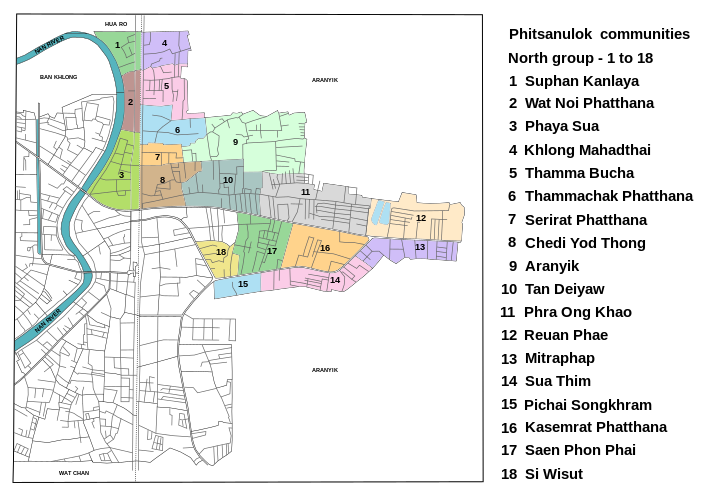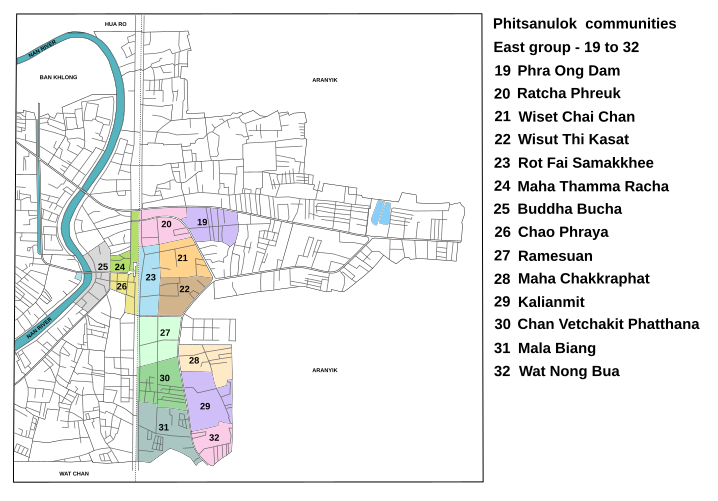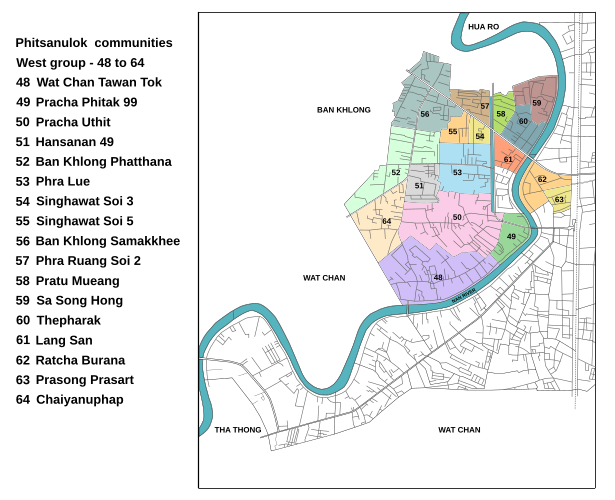Phitsanulok
This article has multiple issues. Please help improve it or discuss these issues on the talk page. (Learn how and when to remove these template messages)
|
Phitsanulok
พิษณุโลก Song Khwae • สองแคว | |
|---|---|
| Phitsanulok city เทศบาลนครพิษณุโลก | |
Clockwise from top: The route 12, Chan Royal Palace Historical Center, Wat Aranyik, Rama I Equestrian Statue, Phitsanulok Clock Tower, Wat Phra Si Rattana Mahathat | |
|
UTC+7:00 (ICT) | |
| Postal code | 65000 |
| Calling code | (+66) 55 |
| Geocode | 650101 |
| Chief roadway | Route 12 |
| Chief watercourse | Nan River |
| Chief airport | Phitsanulok Airport |
| Website | www |
Phitsanulok (
Toponymy

- Song Khwae: The first element, song, means the number 'two'. The second element, khwae, means 'tributary', hence 'two rivers'.
- Phitsanulok: The first element, Phitsanu (Thai: พิษณุ; Sanskrit: loka लोक 'world') means 'globe' or 'world'. A loose translation of the entire name would be 'Vishnu's heaven'.
History
Phitsanulok is one of the oldest
Phitsanulok was originally named "Song Khwae" (lit. "Two Rivers") as it used to situate between the
During the

King
The Burmese General
As a part of reforms of King Chulalongkorn, Phitsanulok became the administrative seat of the
- The Phitsanulok fire of 1957 destroyed much of the older portion of the city, which at the time consisted mostly of wooden buildings.
- On 28 November 1961, the King Naresuan Shrine was completed at Chandra Palace.
- On 25 January 1967, the Phitsanulok campus of what is now Naresuan University was established as the northern branch of the degree level College of Education. In 1974, the College of Education was upgraded as Srinakharinwirot University, with Phitsanulok as one of the six campuses. In 1990, the regional campuses became independent universities, and the Phitsanuloke campus was named after Phitsanulok-born King Naresuan the Great.
- Naresuan Dam was constructed from 1976 to 1985 on the Nan River as part of the Phitsanulok Irrigation Project.[6] The dam was designed to help prevent flooding of the city.
- On 8 March 1999 Phitsanulok was upgraded to city municipality (thesaban nakhon).[7]
Symbols
- (photo left) From left to right: three figures symbolize Wat Yai: Phra Attharot, a 9 meter high standing Buddha image, the 36 meter high prang and the entrance gate of Vihara Luang, which enshrines Buddha Chinnarat; a nature park with a waterfall; for houseboatson the Nan river; King Naresuan riding his war elephant; hat-shaped tower.
- (photo right) above: Seal of Phitsanulok City depicts King Naresuan, shown riding his war elephant (yellow), bottom: Phitsanulok City (Thai: thesaban nakhonPhitsanulok) (green).
Geography
Location

Phitsanulok is in the north of Thailand. Phitsanulok is about 377 kilometres north of Bangkok by road. Phitsanulok covers some 10,815 square kilometres, or 6.4% of area in the north of Thailand and 2.1% of the area of Thailand. Phitsanulok borders on the north and the north-east of Thailand. The north is adjacent to
Topography
Phitsanulok lies primarily on flatland with some hills.
Climate
Phitsanulok has a tropical savanna climate (Köppen climate classification Aw). Winters are dry and very warm. Temperatures rise until April, which is very hot with the average daily maximum at 37.4 °C (99.3 °F). The monsoon season runs from May through October, with heavy rain and somewhat cooler temperatures during the day, although nights remain warm.
| Climate data for Phitsanulok (1991–2020) | |||||||||||||
|---|---|---|---|---|---|---|---|---|---|---|---|---|---|
| Month | Jan | Feb | Mar | Apr | May | Jun | Jul | Aug | Sep | Oct | Nov | Dec | Year |
| Record high °C (°F) | 36.3 (97.3) |
38.4 (101.1) |
40.5 (104.9) |
42.8 (109.0) |
42.7 (108.9) |
39.4 (102.9) |
37.6 (99.7) |
36.7 (98.1) |
35.7 (96.3) |
35.7 (96.3) |
36.4 (97.5) |
35.3 (95.5) |
42.8 (109.0) |
| Mean daily maximum °C (°F) | 31.5 (88.7) |
33.5 (92.3) |
35.7 (96.3) |
37.2 (99.0) |
35.8 (96.4) |
34.3 (93.7) |
33.2 (91.8) |
32.6 (90.7) |
32.7 (90.9) |
32.6 (90.7) |
32.3 (90.1) |
31.0 (87.8) |
33.5 (92.4) |
| Daily mean °C (°F) | 24.9 (76.8) |
26.8 (80.2) |
29.1 (84.4) |
30.8 (87.4) |
30.1 (86.2) |
29.3 (84.7) |
28.6 (83.5) |
28.2 (82.8) |
28.2 (82.8) |
28.0 (82.4) |
26.9 (80.4) |
24.9 (76.8) |
28.0 (82.4) |
| Mean daily minimum °C (°F) | 19.2 (66.6) |
20.8 (69.4) |
23.7 (74.7) |
25.4 (77.7) |
25.4 (77.7) |
25.2 (77.4) |
24.8 (76.6) |
24.7 (76.5) |
24.7 (76.5) |
24.1 (75.4) |
22.0 (71.6) |
19.4 (66.9) |
23.3 (73.9) |
| Record low °C (°F) | 7.5 (45.5) |
10.0 (50.0) |
12.7 (54.9) |
19.6 (67.3) |
20.4 (68.7) |
21.0 (69.8) |
21.5 (70.7) |
21.4 (70.5) |
21.7 (71.1) |
17.1 (62.8) |
12.1 (53.8) |
8.9 (48.0) |
7.5 (45.5) |
| Average precipitation mm (inches) | 7.0 (0.28) |
16.6 (0.65) |
28.9 (1.14) |
59.2 (2.33) |
165.6 (6.52) |
161.1 (6.34) |
187.9 (7.40) |
240.7 (9.48) |
268.4 (10.57) |
139.1 (5.48) |
31.7 (1.25) |
12.9 (0.51) |
1,319.1 (51.93) |
| Average precipitation days (≥ 1.0 mm) | 1.0 | 1.3 | 2.4 | 3.8 | 10.0 | 11.9 | 14.4 | 15.6 | 15.2 | 9.4 | 2.2 | 0.7 | 87.9 |
| Average relative humidity (%)
|
69.1 | 66.1 | 64.4 | 63.6 | 71.3 | 76.1 | 78.6 | 80.7 | 81.6 | 78.7 | 72.6 | 69.0 | 72.7 |
| Mean monthly sunshine hours | 258.7 | 252.2 | 265.6 | 271.9 | 243.3 | 186.5 | 150.8 | 141.1 | 160.7 | 209.4 | 246.3 | 257.7 | 2,644.2 |
| Mean daily sunshine hours | 8.3 | 8.6 | 8.9 | 8.1 | 6.4 | 3.9 | 3.9 | 3.8 | 3.6 | 5.8 | 7.3 | 8.3 | 6.6 |
| Source 1: World Meteorological Organization,[10] (extremes)[11] | |||||||||||||
| Source 2: Office of Water Management and Hydrology, Royal Irrigation Department (sun 1981–2010)[12] | |||||||||||||
Administration
The administration of Phitsanulok City Municipality is responsible for an area that covers approximately 18.26 km2 (7.05 sq mi) and consists of only tambon Nai Mueang with 62,584 people and 37,507 households.[1]

According to Municipal Act B.E. 2496 (1953, reviewed in 2003), the duties of the municipality include: clean water supply, waste and sewage disposal, communicable disease control, public training and education, public hospitals and electricity. The mayor, or the highest executive, is directly elected by the eligible voters in the municipal area. The mayor serves a four-year term and is assisted by no more than four deputy mayors appointed directly by the mayor. The Municipal Council is the legislative body of the municipality. It has the power to issue ordinances by laws, that do not contradict the laws of the country. The municipal council's jurisdiction applies to all people living in the municipal area.
There are a total of 64 communities (
Demographics
Ethnic diversity
The majority ethnicity in the city is Thai. Others in the city consider themselves of Mon descent.
Language
The majority of residents of Phitsanulok speak
Religion
The people of Phitsanulok are predominantly Theravada Buddhists (as are 95% of the Thai population as a whole), with a small Christian community and a few Muslim families.
Education
Educational institutions

Vocational institutions
There are three vocational colleges in the city:
- Phitsanulok Technical College.[1]
- Phitsanulok Vocational College.[2]
- Songkwae Technical College
Secondary (Mathayom) institutions
Phitsanulok City is home to three secondary institutions:
- Chalermkwansatree school.[3] Archived 11 July 2021 at the Wayback Machine
- Janokrong school.[4] Archived 26 August 2018 at the Wayback Machine
- Puttha Chinnarat Pitthaya school.[5]
Healthcare
There is one government hospital in Phitsanulok City: Buddhachinaraj Phitsanulok Hospital with 1,000 beds.
There are also five private hospitals with 400 beds total:
- Bangkok Hospital Phitsanulok [6] Archived 4 March 2021 at the Wayback Machine
- Phitsanulok Hospital [7] Archived 27 September 2021 at the Wayback Machine
- Pitsanuvej Hospital [8]
- Ruamphaet Hospital
- Radiotherapy and Nuclear Medicine Hospital
Infrastructure

Airport
Close to the city center (Aranyik), Phitsanulok Airport receives up to six flights a day from Bangkok (flight time approximately 60 minutes), which are operated by three airlines: Nok Air, Thai Air Asia and Thai Lion Air.
Roads
Road 126, a multi-lane by-pass enables through-traffic to avoid the city of Phitsanulok, and connects to
Buses
Phitsanulok Terminal 1 (Saen Phon Phai) and Terminal 2 (Samo Khae) provide the mass transport throughout Phitsanulok Province by some eight bus companies. Four minibus lines provide transportation around the city. Yanyon tour operates its own private bus station (Sua Thim) with only a busline to Bangkok.
Railway
In the city center, Phitsanulok railway station mainly receives intercity trains on the Northern Line, operated by State Railway of Thailand, more than a dozen trains running in each direction each day.
Media
The main channels for communication in the city are television and radio. The following public television and radio stations[14] are broadcast from Phitsanulok:
- Sathaanii Witthayu Krajaisiang Thahaan Aakaat (Air Force Radio Station), 954 AM and 95.75, in the City of Phitsanulok
- Witthayu Kong Phon Thahaan Raap Thii Sii (4th Infantry Division), 1377 AM, at Fort Somdet Phra Naresuan Maharat
- Sathaanii Witthayu Phitaksantiraat (Communications Division, Royal Thai Police), 1422 AM, in Phitsanulok City
- ARMY-5 (television channel 5, owned and operated by the Royal Thai Army)[15]
- PRD-11 (television channel 11, owned and operated by the Government Public Relations Department)[15]
Royal Thai Army
Phitsanulok is home to the Third Army Region of the Royal Thai Army, responsible for the northern and north-western parts of the kingdom.
Temples

Wat Phra Sri Rattana Mahathat
Phitsanulok's main tourist attraction is Wat Phra Sri Rattana Mahathat, known locally simply as Wat Yai (

Other temples

The city is also home to the following temples where
- Wat Tammachak (Thai: วัดธรรมจักร)
- Wat Chedi Yod Thong (Thai: วัดเจดีย์ยอดทอง)
- Wat Aranyik (Thai: วัดอรัญญิก)
- Wat Nang Phaya (Thai: วัดนางพญา), not a temple but a monastery
- Wat Ratcha Burana (Thai: วัดราชบูรณะ)
- Wat Mai Opai Yaram (Thai: วัดใหม่อภัยาราม)
- Wat Si Wisut Tharam (Thai: วัดศรีวิสุทธาราม)
- Wat Nong Bua Mai (Thai: วัดหนองบัวหม่อ)
- Wat Tha Maprang (Thai: วัดท่ามะปราง)
- Wat Sa Kaew Phatum Thong (Thai: วัดสระแก้วปทุมทอง)
- Wat Chan Tawan Ook (Thai: วัดจันทร์ตะวันออก)
- Wat Chan Tawan Tok (Thai: วัดจันทร์ตะวันตก)
- Wat Phan Pee (Thai: วัดพันปี)
- Wat Kuha Sawan (Thai: วัดคูหาสวรรค์)
Sports
Dragon boat racing has historically been an important element of Phitsanulok culture. In recent times, football (soccer) has become increasingly popular. In 2005, Phitsanulok won the 2nd Northern Youth Football Championship in the U12 and U15 age groups.[16]
Traditional
Culture
Art
Phitsanulok is home to a number of historic sculptures of the Buddha and other religious artwork including the
Literature
Examples of important literary works of Phitsanulok include:
- Lilit Yuan Pai (Thai: Lanna)
- Lilit Prá Lô (Thai: ลิลิตพระลอ, English: Tale of the Hero Lô)
- Klohng Táwâatsàmàat (Thai: โคลงทวาทศมาส, English: Poem of the Twelve Months)
- Gam Sŏn Sĕe Bpràat (Thai: กำศรวลศรีปราชญ์, English: The Legendary Wise Archer's Grip)
The predominant literary language (as well as the predominant spoken language) is the central Thai dialect of the
Other attractions


- Buranathai Buddha Foundry: Specializes in casting bronze Buddha images.Phra Buddha ChinnaratBuddha image. Visitors are permitted to walk along the production line.
- Sergeant-Major Dr. Thawee Buranakhet Folklore Museum: Hosts a collection of folk arts, crafts, basketry, pottery and ancient kitchen utensils.[18] The museum also houses a collection of antique traps for catching snakes, birds, tigers and porcupines.
- City walls: Most of the older portions of Phitsanulok were destroyed in a 1955 fire. Thus little else remains of the old town besides the famous temple, an ancient chedi across the road from it, and a small section of the city wall. The intact portion of the ancient city wall is accessible to visitors.[18]
- Night Market: Each evening, vendors gather to form Phitsanulok's night market. Items sold include clothing and food, usually at reduced prices.
- Chan Palace was the birthplace of King Naresuanthe Great, and contains a shrine to him.
- Naresuan University Art and Culture Gallery: The gallery holds over 100 artistic artworks of culturally significant Thai artists.
- Nan River Houseboats: Phitsanulok is known throughout Thailand for the A houseboat museum is open to visitors.
Festivals and events
- Phra Buddha Chinnarat Fair: Held each January at Wat Phra Sri Rattana Mahatat Woramahawihan.
- Suan Chom Nan Park Festival: Held twice a year along the Nan River. Food and local products are on sale.
- Dragon Boat Races: On the first weekend of each October, dragon boat races are held outside Wat Phra Sri Rattana Mahatat Woramahawihan in the Nan River. Each dragon boat has a crew of approximately 30 oarsmen.
References
- ^ a b "official statistics registration system". Department of Provincial Administration. Retrieved 20 March 2023, > year 2022 >village level >Excel File > no.65010100 > Excel line 71543
{{cite web}}: CS1 maint: postscript (link) - ^ "2. Administrative Information". บรรยายสรุปอำเภอเมืองพิษณุโลก [Mueang Phitsanulok Briefing] (Report) (in Thai). Mueang Phitsanulok Administrative Office. 5 October 2020. p. 4.
- ISBN 978-974957544-4. Retrieved 19 March 2021.
- ^ เจียจันทร์พงษ์, พิเศษ (2020). เมืองในประวัติศาสตร์ยุคสุโขทัยอยุธยา พระมหาธรรมราชากษัตราธิราช. Matichon.
- ^ บรรจุน, องค์ (2010). สยาม :หลากเผ่าหลายพันธุ์. Matichon Public Company Limited.
- ^ Phitsanulok Irrigation Project Archived 2008-05-03 at the Wayback Machine
- ^ "พระราชกฤษฎีกา จัดตั้งเทศบาลนครพิษณุโลก จังหวัดพิษณุโลก" [Royal Decree Establish of Thesaban Nakhon Phitsanulok Changwat Phitsanulok] (PDF). Royal Thai Government Gazette. 116 (14 Kor): 5–10. 8 March 1999. Archived from the original (PDF) on 10 November 2011. Retrieved 14 December 2019.
- ^ ThaiTambon.com Archived 26 March 2008 at the Wayback Machine[not specific enough to verify]
- ^ Basins in Thailand Archived 2008-02-22 at the Wayback Machine
- ^ "World Meteorological Organization Climate Normals for 1991–2020". World Meteorological Organization. Retrieved 12 October 2023.
- ^ "Climatological Data for the Period 1981–2010". Thai Meteorological Department. Retrieved 4 August 2016.
- ^ "ปริมาณการใช้น้ำของพืชอ้างอิงโดยวิธีของ Penman Monteith (Reference Crop Evapotranspiration by Penman Monteith)" (PDF) (in Thai). Office of Water Management and Hydrology, Royal Irrigation Department. p. 32. Retrieved 31 July 2016.
- ^ "64 communities into 4 groups". www.phsmun.go.th. Archived from the original on 22 October 2016. Retrieved 19 August 2019. "เทศบาลนครพิษณุโลก | Phitsanulok Municipality | ชุมชน". Archived from the original on 22 October 2016. Retrieved 28 March 2021.
{{cite web}}: CS1 maint: bot: original URL status unknown (link) - ^ Radio Stations in Phitsanulok Province, Thailand
- ^ a b Thai TV: Television Stations in Thailand on VHF and UHF
- ^ "Phitsanulok wins the 2nd Northern Youth Football Championship". Archived from the original on 1 May 2006. Retrieved 17 October 2007.
- ^ Buranathai Buddha Casting Foundry[dead link]
- ^ a b c Thailand Guidebook-Phitsanulok Province
External links
- Official website
 Phitsanulok travel guide from Wikivoyage
Phitsanulok travel guide from Wikivoyage













